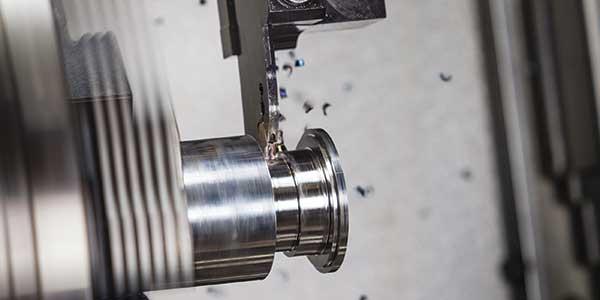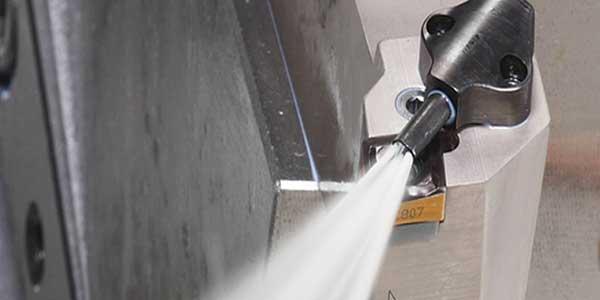- FMA
- The Fabricator
- FABTECH
- Canadian Metalworking
Changing How You Turn
Using high-pressure coolant, especially in operations like deep grooving, increases tool life, improves process security
- By Joe Thompson
- February 10, 2014
- Article
- Management

Chip control, especially during grooving and parting-off operations, can be problematic unless high-pressure coolant is used. Photo courtesy of Sandvik Coromant Canada
While current high-pressure coolant (HPC) usage trends aren’t exactly creating a coolant renaissance, the conversation is causing a re-evaluation in some shops.
Many shops still use the traditional method of employing coolant: Direct a tube at the work zone and flood the area. This technique, however, limits material removal and does nothing to deal with the operator’s bane of birdnesting.
By using HPC, and, most importantly, using it correctly, manufacturers can solve several machining problems at one time.
The three main benefits to using HPC are:
- Improved chip control.
- Increased cutting speed.
- Longer tool life.
Chip control, especially during internal turning or deep-grooving operations, typically is problematic. Flood coolant has difficulty reaching the cutting zone, but high-pressure, through-the-tool coolant systems deliver coolant to where it is needed the most.
The Wedge Effect
During the application of HPC, a high-velocity jet of coolant creates a “hydraulic wedge” between the chip and the insert. This provides more efficient cooling of the insert close to the hot contact zone at the cutting edge and forces the chip away from the insert face quickly, reducing wear on the insert. It also helps break the chip into smaller pieces and evacuate it from the cutting area.
“This hydraulic wedge shortens the contact length between the chip and the rake face,” explained Kevin Burton, turning product manager for Sandvik Coromant Canada. “It is created when the tool’s coolant nozzles are directed correctly. When cutting materials that produce long chips or create a lot of heat, high-pressure coolant, properly directed, will have a great effect on the process.”
Smaller chips are evacuated faster and easier, with less likelihood of damaging the part, tool, or toolholder.
Removing heat from the cutting zone is important in any turning operation, but when the material is a heat-resistant superalloy (HRSA), such as the popular INCONEL® 718, it becomes critical.
Turning these HRSAs can create temperatures in the work zone that exceed 1,000 degrees C because of the material’s hardness and poor thermal conductivity. This heat can cause traditional flood-type coolant to instantly evaporate, creating a pressurized zone that impedes the coolant from getting to the cutting edge. Using HPC stops this from happening.

A hydraulic wedge is created by properly directed, high-pressure coolant. Photo courtesy of ISCAR Tools Canada.
“High-pressure coolant cools the chip more rapidly, making it more brittle and, therefore, easier to break,” said Burton. “In the big picture, this means that process security is improved, surface finishes are better, and the machine needs to be stopped less frequently to clear chips.”
While the obvious chip-breaking improvements will be seen in ISO S materials (titaniums and HRSAs) and stainless steels (ISO M), steels (ISO P) will also show improvement with coolant delivery at 1,000 PSI.
However, using new tooling that is better able to direct coolant to the cutting zone without increasing coolant pressure also can prove beneficial.
“By using high-pressure coolant tools at normal pressure, the concept turns into high-precision coolant, if you will. Tool life still is improved at the normal cutting speed,” explained Burton.
Improved Coolant Delivery
In a typical flood-coolant operation, the coolant is sprayed from a location that is well away from the cutting edge. In this situation, the chip even acts as an “umbrella” by keeping the coolant away from the cutting zone. This means that the cut is not well-lubricated or cooled at the cutting edge.
“In normal flood-coolant situations, all you are doing is cooling the chip,” explained Steve Geisel, senior product manager for Iscar Tools Canada. “While cooling the chip is beneficial for chip control, you don’t necessarily get the full benefits that high-pressure coolant use can provide.”
The HPC method requires no change to the machine tool itself, only the tooling system.
“We have found that using tools designed for high-pressure coolant at standard pressures will still create a machining advantage over flood-coolant usage,” said Geisel. “It’s more focused delivery. It delivers the coolant very close to the cutting edge.”
Tool Life Versus Productivity
According to sources, one of the benefits of HPC is increased tool life. Using higher pressures reduces the heat generated in the cutting zone, and when you reduce this heat, tool life improves.
You may not, however, necessarily want to increase tool life. Instead, you can increase the cutting data to reduce your cycle time without extending tool life. “We advise shops to take the tool life increases that are created and dump them back into production,” said Geisel. “By reducing cycle time instead of increasing tool life, overall per-part costs can come down. For example, if a shop is currently getting 50 pieces per insert using standard coolant pressure, and this is increased to 75 pieces by using high-pressure coolant, we tell them to keep their production level at 50 pieces, but increase their spindle speed, feed rate, depth of cut, or a combination of all three.”
The reason for this is simple: Cycle time has more effect on the final cost of the part than tool life.
“Reducing cycle time will be much more cost-effective for the process than any improvement in tool life can be,” said Geisel. “This is because tooling accounts for only about 3 percent of the total cost of the piece.”
In the best-case scenario, using HPC will double tool life, which still means that only 1.5 percent of the total cost of the part will be saved. If you choose to reduce the cycle time instead, you may achieve bigger savings.
“For every minute of cycle time you reduce, you are saving between $1 and $3, depending on how much you charge for machining time,” said Geisel. “Just by using high-pressure coolant and the appropriate tooling you could affect your overall cost per part by between 10 and 20 percent, not just 1.5 percent.”
The Heat Effect
The performance of any carbide tool is based on heat. Each carbide grade and coating is created to work within a certain heat band, for example, between 500 and 700 degrees C. However, if this same tool is used with HPC, the temperature will drop out of the needed range.
The danger created in this scenario is that the tool will now be affected by built-up edge (BUE).
“If the heat in the cutting zone isn’t in the correct heat band, you will not have a nice slippery surface for the swarf to move over,” said Geisel. “This is another reason we tell machinists that are using high-pressure coolant to increase the cutting data. Doing so makes sure that even though the cutting zone is being cooled better, they stay within the heat band that the tool has been designed for.”
To create the best possible metalremoval scenario, you must find the sweet spot.While the tool manufacturer can give estimates on what cutting data should be used, you may have to perform some tweaking for your shop’s specific parts.
Coolant Filtration
One segment of the machining process that becomes even more important when HPC is used is coolant filtration.
The nozzles of high-pressure tools have diameters that typically are between 0.6 and 1.2 mm. Even the tiniest particulate that makes it through the filtration system can easily clog the tool.
“This is a worst-case scenario as far as the machining process is concerned,” said Geisel. “If the tool’s nozzle gets clogged, coolant flow will stop suddenly, which can lead to a catastrophic failure of the tool, damage to the part, or even damage to the machine.”
While this can happen, it is a rare occurrence.
“Systems that create the high pressure in the coolant have multiple levels of filtration to make sure that even the smallest chip fragment gets caught before it goes back through the tool,” said Geisel.
To Cool or Not to Cool
A relatively new theory in turning is that of dry turning. Some experts recommend running turning operations dry if intermittent or interrupted cutting conditions are experienced. This type of operation can create thermal shock, and coolant can intensify the negative effects.
subscribe now


Keep up to date with the latest news, events, and technology for all things metal from our pair of monthly magazines written specifically for Canadian manufacturers!
Start Your Free Subscription- Trending Articles
- Industry Events
MME Winnipeg
- April 30, 2024
- Winnipeg, ON Canada
CTMA Economic Uncertainty: Helping You Navigate Windsor Seminar
- April 30, 2024
- Windsor, ON Canada
CTMA Economic Uncertainty: Helping You Navigate Kitchener Seminar
- May 2, 2024
- Kitchener, ON Canada
Automate 2024
- May 6 - 9, 2024
- Chicago, IL
ANCA Open House
- May 7 - 8, 2024
- Wixom, MI














